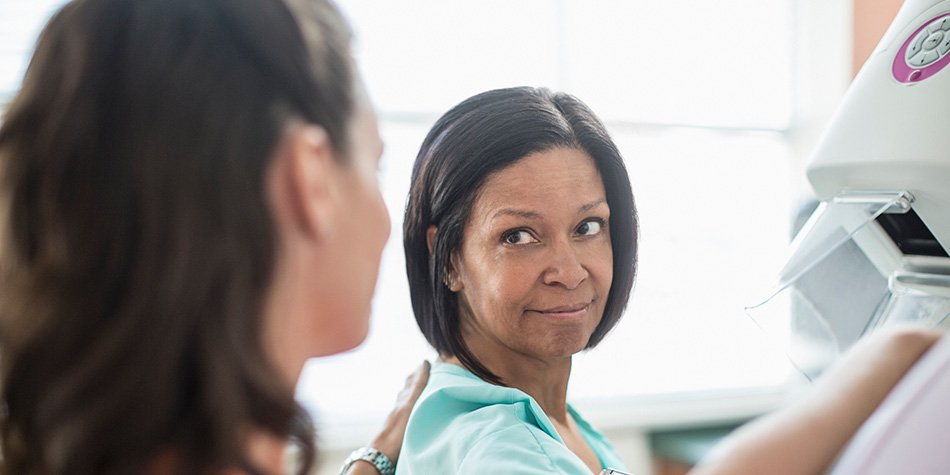
Triple negative breast cancer (TNBC) makes up only 10-15% of all breast cancer diagnoses. That may seem like a small percentage of all the breast cancer cases in the U.S., but TNBC disproportionately affects black women under the age of 40 – a racial group already greatly impacted by breast cancer.
A 2022 report released in October by the American Cancer Society (ACS) reported that black women under 50 are twice as likely as their white peers to die as a result of breast cancer. They are also less likely than any other race to be alive within five years of their diagnosis. While a variety of factors may contribute to these differences including the higher rate of TNBC, it is important to know that experts agree that expanding access to high quality prevention, early detection, and treatment services can reduce these inequalities. It is, therefore, especially important for black women to be vigilant in their breast health care.
Understanding TNBC
The invasive breast cancer is both fast growing and spreading. It is referred to as triple negative because the cancer cells test negative on:
- having estrogen receptors,
- have progesterone receptors,
- and they either don’t make any or make too much of the HER2 protein.
The ACS describes receptors as proteins that attach to specific substances in blood. Both normal breast cells and cancerous breast cells use their receptors to grab on to estrogen and progesterone because the hormones help their cells grow.
Types of cancerous breast cells that are dependent on hormone receptors for growth are able to be treated with hormone therapy. For TNBC cancer cells, which do not need hormones to support their growth, hormone therapy is not a tool for treatment. Additionally, many common cancer drugs target the HER2 proteins as an option for breast cancer treatment; but again, for TNBC, the treatment is not applicable. What this means is that women with TNBC have fewer treatment options (mainly surgery, chemotherapy, and/or radiation) for defeating their cancer. Their cancer is also more likely to be discovered an advanced stage and in more locations within the body because of its aggressive nature. Given this and the limited tools for treatment the survival rate for those with TNBC breast cancer is lower than those with other forms of breast cancer.
Signs and symptoms
Despite the difference in the way hormones and proteins play a role in TNBC, the signs and symptoms of are similar to other forms of breast cancer. Although not always cancerous, the most common symptom for breast cancer is the discovery of a lump in the breast. If you discover a lump in your breast, regardless of it feels physically (soft or hard) or if it is or is not causing pain, you need to seek an appointment with your healthcare provider to further examine the lump. The ACS also outlines these additional symptoms that can be associated with breast cancer even if you do not feel a lump.
- Swelling of all or part of a breast, the area under the arm, or near your collar bone
- Skin dimpling
- Breast pain, and or breast skin that is dry, red, flacking, or thickened
- Inverted nipple
- Nipple pain, discharge, or if the nipple has become is red, dry, flaking, or thickened
Should you experience or are currently experiencing any of these symptoms, please seek immediate assistance from your healthcare provider to better determine your breast health.
A path forward
The ACS reports that about 30% of breast cancer may be preventable by maintaining a healthy body weight, being physically active, and limiting your alcohol intake. These tools do not, however, negate breast clinical or self-examinations, nor the necessity for regular mammograms.
Breast clinical and self-exams
Although research has not shown a clear, direct link between regularly performing a clinical, meaning performed by a healthcare provider, or self-breast exam, and early breast cancer detection, they are both tools to keep track of how your breasts look and feel. Knowing how your breasts look and feel normally can and should empower you to share any changes with your healthcare provider immediately.
Sarah Cannon, the Cancer Institute of HCA Healthcare, recommends that women who are 40 years and older consult their doctor annually about a mammogram and breast exam by their physician or practitioner. Women should talk with their physicians regularly starting as early as age 25 about their individualized risk for breast cancer, as higher risk women may benefit from genetic counseling or early screening.
Mammograms
According to the ACS, mammograms are more likely to find breast cancer early, which in turn means aggressive treatment is typically not necessary, and chances of survival are improved.
A mammogram is a safe, low does x-ray that provides an image of the interior of the breast. The image highlights abnormal breast tissue such as, calcifications, masses, asymmetries, and distortions. In itself, an abnormal area on a mammogram is not a confirmation of cancer. A radiologist reads the image and determines if an abnormality may need additional imaging or testing.
By participating in a regular, yearly screening mammogram a baseline is established for your breast health. These mammograms are reviewed by the radiologist and added to your medical file throughout your lifetime creating a comprehensive medical history. Ultimately, yearly screenings are the best way to find breast cancer early. You should speak with your doctors about how often you should receive a mammogram and maintain that schedule.
We are committed to providing comprehensive breast health services, including mammograms, breast ultrasounds and biopsies. Schedule your mammogram today.
$webqFacilityNumber
Need a Physician?